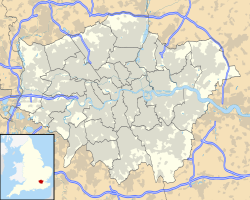London docks
Location of the London Docks in Greater London |

The London Docks were one of many port facilities in the historic London Harbor . They were built in Wapping , 1799–1815, downriver from central London, and cost more than £ 5½ million. Ships used to dock on the Thames , but more berths were needed during this period. The London Docks were the harbor basins closest to the city center until the St. Katharine Docks were built two decades later .
The London Docks occupied a total area of 120,000 m² and consisted of west and east basins, which were connected by the short Tobacco Dock . The west basin was connected to the Thames via the Hermitage Basin in the southwest and the Wapping Basin in the south. The east basin was also connected to the Thames in the east with the Shadwell Basin . The most important planners were the architects and engineers Daniel Asher Alexander and John Rennie . These docks specialized in the unloading of valuable merchandise such as ivory , spices , coffee and cocoa , as well as wine and wool , for which elegant wine cellars and warehouses were built. In 1864 the London Docks were merged with the St. Katharine Docks. The port facilities never had a railway connection. Together with the other port facilities in London, the London Docks were taken over by the Port of London Authority in 1909 .
In 1969 the docks were finally closed to merchant shipping and sold to the Tower Hamlets district council , which had the western part of the London Docks filled in to make them accessible to public housing - a project that was never realized. When the site was sold to the London Docklands Development Corporation (LDDC) in 1981 , it was still an industrial wasteland. Since then, over 1,000 private apartments have been built around the old Tobacco Dock and Shadwell Basin. The controversial printing Fortress Wapping by Rupert Murdoch's company News International was built on the northern half of the backfilled western port basin. 'Hermitage Basin' and Shadwell Basin have remained untouched to this day, but the Wapping Basin is now a sports field and part of the area at the East Basin is still vacant. A small canal runs through the southern part of the former west basin and connects the Hermitage Basin with the Tobacco Dock.
literature
Ben Weinreb & Christopher Hibbert: The London Encyclopedia . Macmillan (1995). ISBN 0-333-57688-8 . P. 486
Individual evidence
- ↑ Phyllis Deane: The First Industrial Revolution . Cambridge University Press. Cambridge (1965). P. 80




